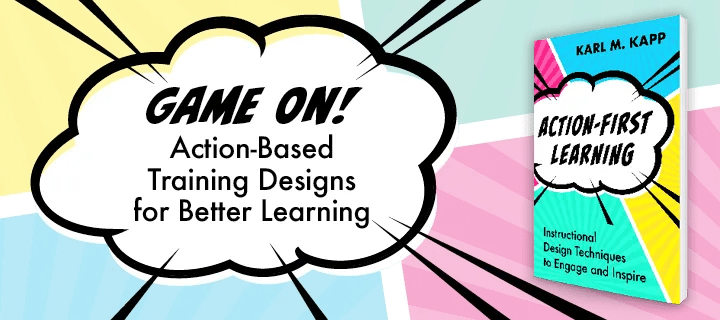ATD Blog
Beyond Gamification: A Move Toward Action-First Learning
Instructional designers can combine action-first learning approaches with gamification to help ensure that learning is grounded in doing, experiencing, and solving real-world challenges.
Wed Apr 09 2025

Which would you choose?
You have just been tasked with designing an e-learning module on ethics. Would you:
Assign points for each ethical question the learner answers correctly and create a “leaderboard”?
Or
Immerse each learner in an ethical dilemma and let them make a critical decision, experiencing the consequences as the module continued?
The answer?
Immerse the learner in an ethical dilemma and force them to make decisions and experience the consequences.
Why?
Assigning points as a method of motivating a learner might work in the short term. However, in the long term, making a decision leads to a deeper understanding or application of ethical principles to actual work situations.
When you immerse the learner in a realistic, high-stakes situation, you force them to cognitively commit to a response that has meaning. The response can then be explored through repercussions and feedback. An action-first approach requires the learner to think critically, evaluate consequences, and make a decision. Research cited at the end of this article supports the effectiveness of action-first learning, showing that experiential and problem-based learning leads to better retention, deeper cognitive engagement, and real-world readiness.
Gamification vs. Action-First Learning: What Is the Difference?
While gamification has value and a place in any instructional designer’s toolkit, the application of game elements such as points, badges, and leaderboards can only take the learner so far. A gamified approach to designing instruction often runs the risk of becoming a superficial overlay of disjointed motivational elements. This haphazard approach means the learner doesn’t develop a deep understanding of what is being taught, nor do they get practice applying the skills they are learning. It is hard for learners to convert the accumulation of points during an e-learning module into an actual conversation with an irate customer. The following chart shows a comparison of the two:
Feature | Gamification | Action-First Learning |
Definition | Adding game elements to a learning experience | Starting with action and learning through doing |
Purpose | Motivation and engagement | Deep learning through real-world application |
Examples | Points, badges, leaderboards, rewards | Case studies, simulations, problem-solving activities |
What is missing from typical gamification is an emphasis on action and activity. Action-first learning provides that emphasis. It is a philosophical approach to designing meaningful instruction that results in learning experiences which require learners to take immediate or initial actions that gain their attention, activate their senses, and encourage them to think critically. Further, it encourages learners to carry that orientation toward action throughout an entire learning experience, culminating in active reflection.
Often action-first learning involves the use of board or card games to engage learners at the beginning of the instruction. However, it can also involve opening activities like think-pair-share and even the use of augmented and virtual reality. The one common thread is the emphasis on learner action to set the tone for the instructional event and to engage multiple senses of the learner.
This doesn’t mean action-first learning and gamification can’t work together. In fact, they can and often should work hand in hand to accomplish desired learning outcomes. For example, an action-first e-learning module teaching ethics might immediately confront learners with a realistic workplace ethical dilemma. Deciding whether to report a valued colleague who has violated confidentiality rules would be the action-first element.
To add meaningful gamification, the learners might receive immediate feedback on their choice in the form of gaining or losing ethical credibility points on an “integrity meter.” This combination of approaches provides the learner with the challenge of overcoming ethical dilemmas and helps them sharpen their decision-making skills while providing feedback on how ethical their decision-making process was. The combination of action and gamified feedback can be extremely motivating.
Conclusion
Gamification and action-first learning are not the same thing. While gamification can be an effective tool, it is not a substitute for structuring learning around action. Instructional designers can combine action-first learning approaches with gamification to help ensure that learning is grounded in doing, experiencing, and solving real-world challenges. This will take their designs beyond gamification into action-first learning.
What action-first strategies have worked for you? Share your experiences in the comments!
To learn more about action-first learning, check out my book Action-First Learning: Instructional Design Techniques to Engage and Inspire.
References
Rotgans, J. I., and Schmidt, H. G. 2011. “Cognitive engagement in the problem-based learning classroom.” Advances in health sciences education: theory and practice 16(4): 465–479. doi.org/10.1007/s10459-011-9272-9.
Bonwell, C. C., and Eison, J. A. 1991. “Active Learning: Creating Excitement in the Classroom.” ASHE-ERIC Higher Education Report. Washington, DC: School of Education and Human Development, George Washington University. files.eric.ed.gov/fulltext/ED336049.pdf.
Seshan, V., Matua, G. A., Raghavan, D., Arulappan, J., Al Hashmi, I., Roach, E. J., Sunderraj, S. E., and Prince, E. J. 2021. “Case Study Analysis as an Effective Teaching Strategy: Perceptions of Undergraduate Nursing Students From a Middle Eastern Country.” SAGE Open Nursing. 7, 23779608211059265. doi.org/10.1177/23779608211059265.

